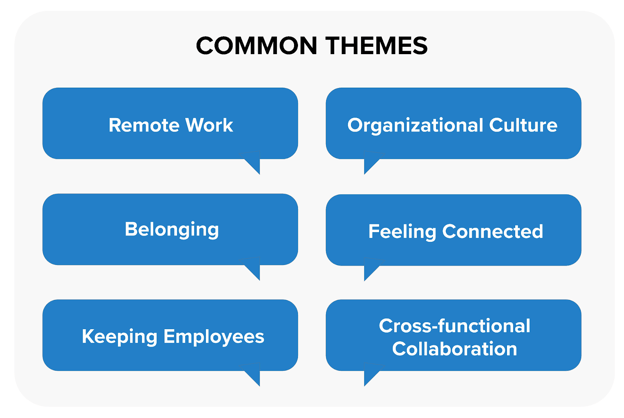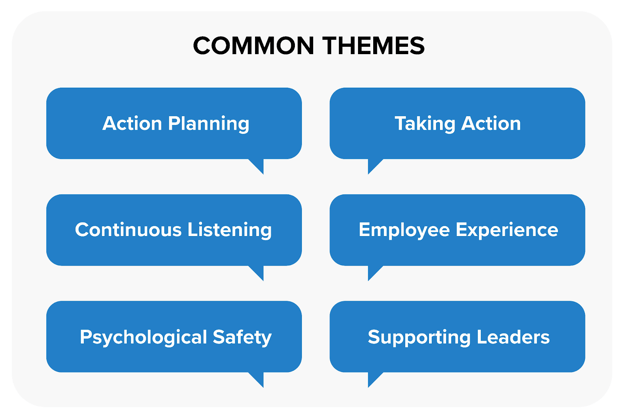Throughout the 2023 INSIGHTS Conference conference, People leaders from Perceptyx, its customers, and partners discussed the rapidly evolving landscape of employee listening and People analytics, along with the challenges of navigating relentless change.
One of the unique ways we captured real-time feedback and ideas from these leaders was through crowdsourcing and voting — an interactive listening experience powered by Perceptyx's Dialogue product. When deployed effectively, Dialogue enables the gathering of real-time insights into people's thoughts and ideas, fostering inclusion, trust, and shared ownership of actions. These surveys focused on three critical areas: hybrid work, People experience, and organizational challenges related to People strategy.
In this blog, we’ll discuss the findings from these crowdsourced surveys, using them as a way to explore some of the opportunities and challenges facing organizations in the year ahead.
Question #1 — What Aspect of Remote/Hybrid Work Ranks as the Greatest Challenge for Your Organization?
As organizations navigate the complexities of remote and hybrid work, certain challenges remain particularly daunting. Based on the responses, the top-ranked challenges were:
- Preserving organizational culture and identity, particularly in creating opportunities for informal interactions without making them feel forced or contrived through virtual methods.
- Ensuring employees feel connected to one another and the organization at large.
- Developing and maintaining a robust organizational culture within a remote/hybrid workforce, where in-person contact and communication are limited.
- Fostering a sense of belonging and connection among colleagues in a virtual environment.
- Encouraging cross-functional collaboration and cultivating relationships beyond employees' immediate teams.
These findings reaffirmed core concerns related to nurturing connections, maintaining culture, and facilitating meaningful collaboration, and highlight the need to prioritize human connections in a digital environment.

The preservation of organizational culture and identity in remote and hybrid settings is crucial to ensuring employees feel a sense of belonging and commitment to the organization. Leaders can address this challenge by integrating virtual team-building activities, encouraging frequent check-ins, and promoting transparency in communication. By fostering an environment where employees feel comfortable engaging informally, leaders can help build stronger connections and maintain a cohesive organizational culture.
Employee engagement and connection to the organization are critical factors in driving productivity and retention. To tackle this issue, organizations should invest in digital communication tools and platforms that enable employees to easily collaborate and interact. Regular virtual meetings, open channels for communication, and designated “drop-in” spaces for casual conversation can help bridge the gap created by physical distance.
Building and maintaining a strong organizational culture in a remote or hybrid workforce requires conscious effort and intentionality. Leaders should prioritize communication of organizational values and expectations, ensuring employees understand the company's mission and goals. Additionally, recognition programs and virtual events can be used to celebrate achievements and reinforce cultural norms, even when employees are working remotely — though employee listening should be utilized to ensure these are having their intended effects.
Creating a sense of belonging and connection for colleagues in a remote or hybrid work environment can be achieved through inclusive practices and by fostering empathy. Encourage open dialogue, value diverse perspectives, and provide support for employees navigating the challenges of remote work. By demonstrating understanding and care for employees' well-being, organizations can create a sense of connection even when working remotely.
Lastly, cross-functional collaboration and relationship-building outside of immediate teams are crucial for innovation and problem-solving. Organizations can implement virtual workshops, mentorship programs, and joint projects to break down silos and foster collaboration across functions. By providing employees with opportunities to connect and work with colleagues from different departments, organizations can enhance teamwork and drive innovation.
Question #2 — What Is the One Thing You Could Do to Have the Greatest Impact on Your People Experience This Year?
Based on the responses, the top-ranked strategies identified by INSIGHTS attendees were:
- Translating data into tangible insights, actions, and behaviors that managers can apply.
- Acknowledging the human aspect of change and considering employees' experiences while executing business strategy.
- Fostering a sense of psychological safety and value by ensuring employees feel heard and involved in the decision-making process.
- Supporting leaders in taking meaningful action to develop the aspects of organizational culture that matter most to their people.
- Utilizing collected data to narrate a story and drive action.
These findings reemphasize the importance of data-driven decision-making, empathetic leadership, and creating an environment where employees feel valued and supported.

Translating data into actionable insights and behaviors is crucial in guiding managers to make informed decisions. Organizations can invest in advanced analytics products — like Perceptyx’s People Insights Platform — to help managers better understand and interpret the data, leading to more effective problem-solving and decision-making.
Recognizing the human aspect of change is vital for maintaining employee engagement and satisfaction. Organizations should prioritize open communication, providing support to employees during periods of change, and understanding their concerns. This empathetic approach can create a more positive people experience and foster a more resilient workforce.
Creating an environment of psychological safety and value is key to employee well-being and performance. By promoting transparency, actively involving employees in the action-planning process, and demonstrating that their input is valued, organizations can help employees feel more in control of their experience and more invested in the company's success.
Supporting leaders in taking meaningful action to develop a strong organizational culture can have a significant impact on People's experience. This can be achieved by offering leadership development programs, sharing or reevaluating best practices, and providing resources that empower leaders to shape a culture that aligns with employee needs and expectations.
Finally, using collected data to tell a story and drive action allows organizations to address pressing issues and make informed decisions. By presenting data in a compelling and relatable manner, organizations can inspire action and ensure that their people strategy aligns with employee needs.
Question #3 — What’s the Single Greatest Challenge Facing Your Organization This Year (As It Relates to Your People Strategy)?
Here, the top-ranked responses were:
- Balancing talent engagement and retention in a challenging macroeconomic environment that has been marked by inflationary pressure, recession risk, and customer uncertainty, while maintaining fairness and inclusivity among employees at all levels.
- Addressing employee retention, engagement, and burnout challenges amid three years of significant internal and external changes and an uncertain future.
- Adapting business models to stay relevant to clients while ensuring employee initiatives are not left behind, especially during periods of global transition and change.
- Managing uncertainty and change in a declining business environment, working to right-size the organization while creating alignment, buy-in to strategy, and productivity at all levels.
- Navigating the paradox of attracting, retaining, and transforming talent in a constantly evolving landscape.
To address employee engagement and retention, leaders must strive for open communication and demonstrate their commitment to employee well-being. Executives should ensure that employees are informed about the company's performance and understand the rationale behind budget constraints and policy changes. By fostering transparency and trust, organizations can mitigate feelings of disenfranchisement and cultivate a more engaged workforce.
Managing employee retention, engagement, and burnout amid ongoing change requires a holistic approach to well-being, incorporating mental, emotional, and physical health initiatives. Organizations should invest in wellness programs, offer flexible work arrangements, and provide resources to help employees cope with stress and burnout. In addition, senior leaders can promote a culture of empathy and support, acknowledging employees' struggles and providing encouragement.
Adapting business models to stay relevant requires balancing client needs with employee development initiatives. Senior leaders must ensure that resources are allocated not only to business transformation efforts but also to employee upskilling, training, and development programs — the best way, as demonstrated by recent Perceptyx research, to retain top performers. By maintaining a focus on employee growth, organizations can reduce the risk of attrition and disengagement while staying competitive in the market.
Uncertainty and change management call for strong leadership, clear communication, and an inclusive approach to decision-making. Senior leaders should actively involve employees in the change process, using employee listening to build a culture of continuous conversation in order to maintain open lines of communication to ensure alignment and buy-in. By fostering a culture of trust and collaboration, organizations can better navigate challenging times and maintain productivity at all levels.
Lastly, the paradox of attracting, retaining, and transforming talent necessitates a strategic approach to workforce planning. Senior leaders must develop a comprehensive talent management strategy that balances the need to attract new talent, retain existing employees, and continuously adapt to evolving industry demands. By focusing on talent acquisition, development, and retention, organizations can build a resilient and future-ready workforce.
Crowdsourced Insights That Drive Action
Crowdsourcing powered by Dialogue can enable your organization to act quickly and at scale by inviting employees to collaborate on solutions that might not be captured by any other method of listening. Click here to take our Maturity Model assessment and receive a comprehensive analysis of your listening program's distinct strengths and areas for improvement, such as the inclusion of crowdsourcing, along with personalized recommendations to continue developing your strategy. To learn more about how a partnership with Perceptyx can ensure you are listening through the optimal number of channels, schedule a meeting with a member of our team.
Photo: Christina Wiedebaksh, Manager, Employee Experience for NYU Langone Health (Credit: Matthew Haide, Perceptyx)
